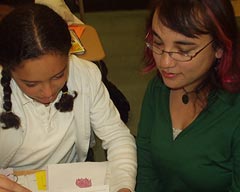 |
|
|
 by Kathryn Gullo My 5th period class drives me to distraction. It has nothing to do with the kids themselves, who are — for the most part — charming and engaging. Their behavior instead is a result of the post-lunch insanity that infiltrates my entire school. Yet, on this particular day, my students were rapt and engaged. It was story time in the truest sense. “Tell me about a time when you laughed harder than you’ve ever laughed before.” There was a brief pause. Hands shot up around the room. I looked at the faces of kids who normally don’t participate and the kids who were failing. Their hands were also raised; they wanted to share their stories. I was in a room full of stories. Memoir is a particularly appropriate genre to tackle with secondary students because they are often so inwardly focused. To move my students into writing memoirs, we began a genre study where we would focus on reading to understand how to write. The genre study would last over several lessons. Lesson One: Easing into Memoirs All year long, my students keep a journal in which they have daily writing assignments. We use a variety of prompts, including Linda Reif’s 100 Quickwrites. On the first day of the genre study, the prompt was “My mother or father once told me….” My students immediately set to work, writing a variety of responses, including poems with advice and anecdotes. During Author’s Chair, we were able to experience what other writers in the class had to write. I pointed out how many memories we had to explore. The pump was primed. On the first day, we read an excerpt of When I Was Puerto Rican (PDF) by Esmeralda Santiago (from Literary Cavalcade). As we read, my students and I discussed dreams and the desire to move away from a neighborhood, to create a better situation for ourselves. Students connected to this piece because they could relate to that sense of being outside and the reality of struggling, and sometimes swallowing one’s pride in order to get ahead. Class ended with a brief discussion using the featured questions, but before my students darted for the door, I wrote the word “MEMOIR” on the board and invited students to begin to try to create definitions. Lesson Two: What’s a Memoir? This was the day to define memoir. My students were given three memoirs from the Critics’ Picks section of Write It: "Hot Combs, Watermelon, and Hello Kitty Backpacks" by A’Rynn Davis "One Step at a Time" by Anant Vinjamoor "Vueltas" by Jessica Colom They choose two stories to read in pairs. Using these readings, they created a chart to answer these questions:
We charted answers on a paper that would remain up for the duration of the genre study. This chart would later become a criteria checklist, or rubric. Students listed critical traits for memoirs: A description of an actual event written in first person and based on truth. Those were the most obvious characteristics. I had to press students to recognize that memoirs often depict a change in the writer’s feelings or ideas and usually focus upon a specific life-changing event, instead of upon an entire life. The question about purpose is essential because memoirs have to be evocative. If students understand why Esmeralda Santiago chose a specific memory to convey a specific experience, then they will carefully select a memory about which to write. Lesson 3: Harvesting the Seeds Taking my cue from Nancie Atwell, I began to ask my class about their memories. Before we started, I had them look at their Writing Ideas page, which is a list of topics about which my students think they could write. But those ideas were only the beginning. We needed to dig deeper. I started with questions from Atwell’s list, but added a few of my own. I would pose a question and wait for my students to think then we’d share drips and drabs of our memories. I shared some of my own, too. The questions we used were:
The conversation started slowly. Students were hesitant to start sharing. But once they did there was a groundswell and students were eager to get their story out. Now they had a seed. To capture it as quickly as possible, I asked students to draw a comic or storyboard illustrating what happened. Next would come narrowing the idea. Lesson Four: How do Memoirs Work? Going back to the excerpt from When I Was Puerto Rican, I asked students to re-read with the eyes of a writer. Now it was time to think more specifically about craft. Students read and listed the most important events on the left side of a t-chart. For each event listed, I asked students to find out why Santiago included the information. To help them focus, I started with this question: Why does Santiago include this? What is she trying to show by including this event? It’s important to push my young writers to see that writing has to reveal something. Often, emerging writers choose to depict events because they happened, rather than because they expose the emotional core of the memoir. After we look at how the memoirs work, we add some more criteria to our original chart from Lesson Two by answering, “What else needs to be in a good memoir?” What I want added, and what I try to encourage my students to see, is that each event has to have a purpose. We need to see what happened before and then after each event in order to understand the impact of the event upon the person writing the memoir. Lesson Five: Revision Revision is an onerous task for most writers. For students, it’s especially painful because they so often seem to kvetch, “But Miss! I already wrote it!” What I saw with the drafts of my students writing was that they were focused and clear, but that they didn’t always portray the specific details of their experiences. I wanted students to create pieces in which the reader could smell what was in the pot on the stove or feel the spray of snow when they sled slipped down the hill. I wanted them to add sensory details. To give them a model from which to work, they read the excerpt from Writing the Senses (PDF) (from Literary Cavalcade). I asked them to draw symbols for each of the five senses (an eye for sight, an ear for hearing, a hand for touch, etc.) on the text as we read. We discussed what they noticed about Alexandra Fuller’s writing, and whether or not it includes a mix of sensory details (not just sight). Looking at specific words, we identified which ones were specific and evocative. Students then coded their own draft. I asked them to be sure they included all of the senses and that it was clear to the reader how what they could see, smell, touch, taste, and hear mattered to the writer. The lessons continued, which is the charm of genre study; like a fish, they can grow to fill the amount of time you have to devote to them. There were also many more memoirs we could read and discuss, such as excerpts from The House on Mango Street, by Sandra Cisneros, or Grandfather’s Journey by Allen Say. With each book, we added to our criteria chart, and we used the various tools of the professional writer to deepen our understanding of craft. Memoirs are a perfect place to create mini-lessons around dialogue, imagery, or pacing. Memoirs become a doorway for students to not only begin to learn the basics of narrative writing, but also invite students to think deeply about their world and to share their lives through language. Kathryn Gullo, a UCLA Writing Project Fellow and a National Board Certified Teacher, currently teaches 7th and 8th grade English (and wrangles 7th and 8th grade students) in the Los Angeles Unified School District. |
||||||
View and print items marked (PDF) using Adobe Acrobat Reader© software, version 4.0 or higher. Items marked (PDF Form) feature editable areas. Save edits with version 7.0 or higher. Get
Adobe Reader for free.
|
|||||||


